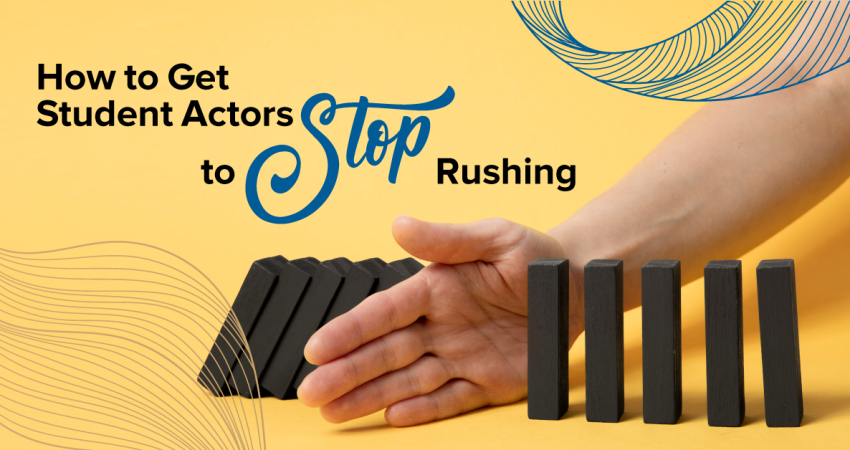A director friend recently sent me a message asking for advice on how to help her students with their upcoming show.
Hi Kerry,
Any tips to help my students slow down and not rush? There are a few places in the show where the moments are “urgent”, but I feel like the audience will miss things as the students rush. We do experiments, I explain to them and ask them to slow down, but they seem to be caught up in the excitement. Or maybe they’re convinced it doesn’t look genuine? Perhaps this will evolve naturally this week as they become more comfortable off-book, but any suggestions would be helpful in the meantime.
I guarantee this is not the first principal to deal with students rushing their lines and moves. Your first task is to try and find out Why your students rush their lines and/or movements. Then you can try some of the following 12 tips and techniques that I’ve used in various situations with my students to help them slow down:
1. “Slow down” may not be specific enough for your students. Try adding gestures or facial expressions at certain points in the scene to help your students focus on their full performance. Some students are visual learners, so it can be helpful to physically demonstrate the movements you want. Our The physicalization of emotions the article might help with that.
2. You may also want to try building in some physical breaks and stops during student turns to force them to slow down. Try to give the exact number you would like the pause to be (eg three seconds versus one second). Alternatively, have students try pausing one beat for a comma or semicolon and two beats for a full stop, question mark, or exclamation mark.
3. Some students don’t believe us when we tell them what they are doing until they see it themselves. Try filming your students’ classes and show them exactly what they’re doing and how much they’re rushing. (I had a director do this for me once – it worked and I finally got the fix!)
4, You could also make rehearsal reference videos of the moments when the students act out the scene as you want, and turn them into official templates for what they have to do each time.
5. Unless students are completely unregulated or shaky with their lines, they may rush to finish the scene. Here are some tips to help students memorize their lines. The earlier the lines are learned, the easier it will be for them to sink comfortably into the scene and avoid rushing.
6. Many students experience nerves or anxiety, which can cause them to rush their lines or movements. Try a few mindfulness techniques to help them combat nervousness and see if that helps them slow down and take their time.
7. Try asking students to pick their lines deliberately slowly – at half speed or even slower. What they feel is half speed is probably an appropriate speed for the scene!
8. If students rush their movements during the scene, ask them to try the scene while moving at half speed or even standing still or sitting. How does this affect their performance?
9. If you find that students are rushing their stage fight choreography, fight directors say that the stage fight performance speed is maximum 75% of a “real” fight. Both because the two combatants need to be able to see what’s going on and the audience needs to know what’s going on. If they move too quickly, the audience will miss important moments. It’s not like in the movies, where the action can be sped up. On stage, we have to suspend our disbelief in order for the action to be seen and understood.
10. Think scientifically. Ask students to think about what their bodies do biologically when they are excited or nervous. What happens when students feel an adrenaline rush? Explain that if they rush in rehearsal now, they will rush even more when the adrenaline hits the week of the show. Your 90-minute show can end up being just an hour!
11. Put yourself in the audience’s shoes. Students sit down and have an honest conversation, considering the situation from the audience’s perspective. The students know the show – the audience doesn’t. The audience has paid to be there and hear the story the actors present. If audience members can’t understand what’s going on, that’s not their fault – it’s up to the actors to help them understand.
12. Have students act out their scenes in front of peers and ask peers to give feedback on speed. Sometimes feedback from their friends and peers can be more enjoyable for students. Alternatively, have someone not part of the show (such as another teacher) sit in on a rehearsal and watch/listen if they rush, as a neutral party unfamiliar with the scenes.
Click here for a free printable tip sheet.
Kerry Hishon is a director, actor, writer and stage fighter from London, Ontario, Canada. She blogs at www.kerryhishon.com.
Want to learn more about our newest pieces, resources, and giveaways?
Get on our list!

